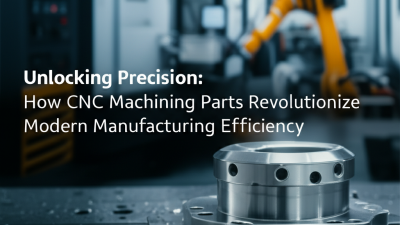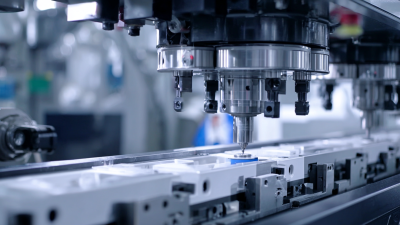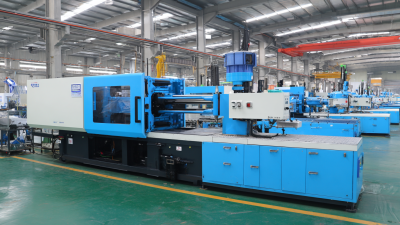
 In today's rapidly evolving manufacturing landscape, CNC machining parts have emerged as a pivotal force driving efficiency and precision. According to a report by Grand View Research, the global CNC machining market is expected to reach $100.71 billion by 2025, reflecting a compound annual growth rate (CAGR) of 6.2% from 2019 to 2025. This surge can be attributed to the increasing demand for precision components in various industries, including aerospace, automotive, and electronics. The ability of CNC (Computer Numerical Control) machining to produce complex designs with remarkable accuracy is revolutionizing production lines, reducing lead times, and enhancing overall productivity. As manufacturers strive to meet the high standards of quality and speed demanded by today’s competitive markets, understanding how to effectively utilize CNC machining parts becomes essential for achieving operational excellence and sustainable growth.
In today's rapidly evolving manufacturing landscape, CNC machining parts have emerged as a pivotal force driving efficiency and precision. According to a report by Grand View Research, the global CNC machining market is expected to reach $100.71 billion by 2025, reflecting a compound annual growth rate (CAGR) of 6.2% from 2019 to 2025. This surge can be attributed to the increasing demand for precision components in various industries, including aerospace, automotive, and electronics. The ability of CNC (Computer Numerical Control) machining to produce complex designs with remarkable accuracy is revolutionizing production lines, reducing lead times, and enhancing overall productivity. As manufacturers strive to meet the high standards of quality and speed demanded by today’s competitive markets, understanding how to effectively utilize CNC machining parts becomes essential for achieving operational excellence and sustainable growth.
The evolution of CNC machining has transformed the landscape of modern manufacturing, with an increasing reliance on digital technologies to drive efficiency and precision. The CNC machine market is projected to experience significant growth, expanding at a CAGR of 5.5% as industries recognize the value of automation and enhanced accuracy. This shift toward automation not only streamlines production processes but also reduces the margin for error, enabling manufacturers to produce parts with unprecedented levels of detail and consistency.
Moreover, the precision tools market is expected to witness a surge, reflecting the rising demand for cutting, drilling, and milling tools that cater to a variety of manufacturing needs. As precision engineering machines forecasted to reach USD 29.16 billion by 2034, businesses are investing in CNC technology to leverage its ability to deliver high-quality outputs efficiently.
This evolution is further fueled by advancements in AI and robotics, which are set to enhance operational capabilities and redefine machining processes across multiple sectors. The integration of these technologies signifies a pivotal moment in manufacturing, marking a shift towards smarter and more responsive production environments.
CNC machining has significantly transformed modern manufacturing through its precision and efficiency, making it an invaluable asset across various industries. One of the primary benefits is the remarkable accuracy it provides. CNC machines operate based on computer-generated designs, which minimizes human error and allows for the production of complex geometries that are consistent in quality. This high level of precision is crucial in sectors such as aerospace and medical devices, where even minor deviations can have serious implications.
Another key advantage of CNC machining is its efficiency in production. The automation of machining processes leads to faster manufacturing times and reduced labor costs. With the ability to run multiple machines simultaneously and produce large quantities of parts with minimal downtime, companies can significantly increase their output. Additionally, the flexibility of CNC machining allows manufacturers to swiftly adjust designs when needed, accommodating changes in market demands or customer specifications without extensive retooling. This adaptability positions CNC machining as a critical component in the modern industrial landscape.
CNC machining has become a pivotal technology in modern manufacturing, offering significant advantages over traditional methods. While conventional manufacturing often relies on manual processes, CNC machining utilizes computer numerical control to automate precision tasks, ensuring consistency and reducing human error. This move towards automation has not only enhanced accuracy but also improved efficiency in production lines by decreasing cycle times, with some reports indicating a reduction in lead times by up to 50%.
In contrast to traditional manufacturing, which can be limited by setup times and operational inefficiencies, CNC machining allows for rapid prototyping and the capability to produce complex geometries that are often impossible or impractical to achieve manually. As highlighted by recent studies, the integration of advanced technologies like AI for predictive maintenance and enhanced demand forecasting further complements CNC operations, streamlining workflows and maximizing output.
**Tips:** To fully leverage CNC machining benefits, manufacturers should consider investing in training programs for their workforce to utilize these technologies effectively. Additionally, adopting a digital-first approach with integrated software solutions can facilitate better data analysis, leading to informed decision-making and inventory management.
| Parameter | CNC Machining | Traditional Manufacturing |
|---|---|---|
| Precision | ±0.01 mm | ±0.1 mm |
| Production Speed | High (parts produced within hours) | Moderate (days to weeks) |
| Material Versatility | Wide range of materials (metals, plastics, etc.) | Limited (primarily metals) |
| Setup Time | Low (programming the machine) | High (manual setup and adjustments) |
| Waste Generation | Minimal (optimized cut paths) | Higher (less efficient material usage) |
| Cost Efficiency for Low Volumes | Higher initial cost, lower overall cost for low volumes | Lower initial cost, higher overall cost for low volumes |
The integration of advanced digital manufacturing technologies has transformed CNC machining into a cornerstone of modern manufacturing efficiency. With projected growth in the European CNC machine market reaching new heights by 2033, the emphasis on technological innovation is clearer than ever. The market is expected to expand across various segments, including lathe machines and milling machines, which are adapting to the increasing demands for precision and speed in production.
Recent trends highlight the emergence of AI and robotics in machining processes, enabling unprecedented improvements in productivity and precision. These technologies are not merely incremental changes; they represent a paradigm shift that disrupts traditional manufacturing workflows. Reports indicate that industries leveraging these innovations are experiencing substantial reductions in lead times and operational costs, allowing manufacturers to remain competitive in a rapidly evolving market landscape. As the manufacturing sector continues to embrace these pioneering advancements, the significance of efficient CNC machining is set to grow even further.
The CNC machining industry is poised for significant developments, with projections indicating the metal manufacturing market will expand from USD 82.09 billion in 2024 to USD 1008.18 billion by 2033, reflecting a compound annual growth rate (CAGR) of 3.1% between 2025 and 2033. This growth is driven by advancements in automation, precision engineering, and the integration of digital technologies, which enhance the efficiency of manufacturing processes. As companies adopt CNC machining, they can produce complex components with greater accuracy and reduced material waste, ultimately leading to cost savings and improved time-to-market.
Looking toward the future, several trends are expected to shape the CNC machining landscape. The rise of additive manufacturing, particularly in metal 3D printing, is revolutionizing traditional manufacturing techniques. Innovations in materials like zirconia (ZrO₂) powder and advancements in artificial intelligence are also playing a crucial role in optimizing production capabilities. As the CNC machining sector evolves, the development of smart factories equipped with interconnected machinery will enable real-time data analysis and machine learning, resulting in even greater operational efficiencies and flexibility in meeting diverse market demands.






Copyright © 2025 The Toolroom Inc. All Rights Reserved.
Website Design St Louis by IQComputing